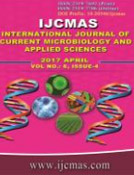


 National Academy of Agricultural Sciences (NAAS)
National Academy of Agricultural Sciences (NAAS)

|
PRINT ISSN : 2319-7692
Online ISSN : 2319-7706 Issues : 12 per year Publisher : Excellent Publishers Email : editorijcmas@gmail.com / submit@ijcmas.com Editor-in-chief: Dr.M.Prakash Index Copernicus ICV 2018: 95.39 NAAS RATING 2020: 5.38 |
Agriculture is going through a profound revolution worldwide due to increasing world demand for food, higher costs of energy and other inputs, environmental pollution problems, and instability of cropping systems. The importance of plant functioning can be realized from the facts that knowledge of mineral nutrition of plants has opened new vistas for fertilizer practices. The detection of deficiencies and toxicity of particular mineral nutrient element has enabled us to make adequate soil amendments and root nutrient absorption for better plant growth. Physiological disorders of many crops such as rice, pulses and oil seeds have been successfully corrected by using minerals. Analysis of plant reveals the presence of a large number of mineral elements. In plant analysis, different mineral nutrient elements are determined even in micro quantities. The estimations are done according to needs either in extracts of fresh plant tissue or by digesting it with nitric acid and perchloric acid. Although plant analysis may be thought of as a method of determining the relative quantities of mineral elements in plants it is at least a crude technique. At present 17 chemical elements such as N, P, K, Ca, Mg, S, B, Cl, Cu, Fe, Mn, Mo, and Zn along with C, H, O are considered as essential elements and each of these essential elements performs one or more specific internal roles in plants. Among the seventeen essential nutrients, some of the nutrients are antagonistic relation to the root growth and some of the nutrients are synergistic relation to the root growth and developments. A less than adequate supply of any one of these essential elements will lead to the metabolic disruptions, including changes in activities of enzymes, rate of metabolic reactions, and concentration of metabolites. In addition to alterations in metabolic patterns, severe deficiencies of individual essential elements also produce a set of characteristic effects in the external appearance of leaves, stems, roots, blossoms, and fruits. In this context, knowledge of factors that affect root development is fundamental to improving nutrient cycling and uptake in soil-plant systems. Roots are important organs that supply water, nutrients, hormones, and mechanical support (anchorage) to crop plants and consequently affect economic yields. In addition, roots improve soil organic matter (OM) by contributing to soil pools of organic carbon (C), nitrogen (N), and microbial biomass. Root-derived soil C is retained and forms more stable soil aggregates than shoot-derived soil C. Although roots normally contribute only 10-20% of the total plant weight, a well-developed root system is essential for healthy plant growth and development. Root growth of plants is controlled genetically, but it is also influenced by environmental factors. Mineral nutrition is an important factor influencing the growth of plant roots, but detailed information on nutritional effects is limited, primarily because roots are half-hidden organs that are very difficult to separate from soil. As a result, it is difficult to measure the effect of biotic and abiotic factors on root growth under field conditions. Root growth is mainly measured in terms of root density, length, and weight. Root dry weight is often better related to crop yields than is root length or density. The response of root growth to chemical fertilization is similar to that of shoot growth; however, the magnitude of the response may differ. In nutrient-deficient soils, root weight often increases in a quadratic manner with the addition of chemical fertilizers. Increasing nutrient supplies in the soil may also decrease root length but increase root weight in a quadratic fashion. Roots with adequate nutrient supplies may also have more root hairs than nutrient-deficient roots. This may result in greater uptake of water and nutrients by roots well supplied with essential plant nutrients, compared with roots grown in nutrient-deficient soils. The use of crop species and cultivars tolerant to biotic and abiotic stresses, as well as the use of appropriate cultural practices, can improve plant root system function under favorable and unfavorable environmental conditions.
 |
 |
 |
 |
 |